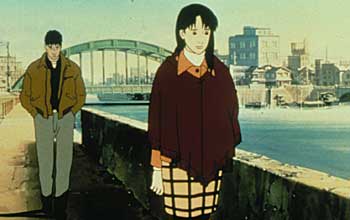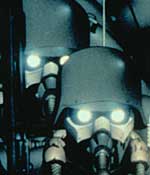
by Luis Reyes
|
Do you feel that was a strong decision on his part? Oshii: I am not unhappy or happy about it, I just respect it. If I had directed it, I think Fuse would have
remained the main character. But after all, the movie is the director's creation. So it's all up to the director to
decide what he wants to do with the movie. So Okiura sympathizes with the girl more. It resulted in more of a love
story.
A twisted type of love story. Oshii: Right.
Earlier you stated that Bandai Visual didn't want you to direct for fear that "Jin-Roh" would be too complicated. If you were to direct it, what direction would it have taken? It's pretty complicated now as it is. Oshii: I actually think it's pretty simple right now. The main difference that I would have made as a
director is that while Okiura told the story of a man and a woman, I would have told the story of a human and a beast.
So the story would have been about the main character's struggle with himself? Oshii: Yes.
Let's shift focus to a specific scene in the film. The first scene opens and immediately captures the audience's attention - the confusion of a riot, a girl running through the sewers, a tragic explosion. And then, with the next scene, the film takes a sudden turn, depicting the various heads of the Capital Police speaking about the political implications of Fuse's action. And it goes on for about ten minutes. I noticed that this change really struck a lot of people. Do you feel the change helped promote the story? Or do you feel that it slowed down the quick pace established in the first scene? Oshii: I think it made it better. "Jin-Roh" is more of a personal story. All the riots and other earlier
scenes are just used for the background. The sudden change of tone actually enhances the film.
So that was a way to shift the focus from Japan as a whole, to this one person. Oshii: Yes.
And about the design elements. The Images in "Jin-Roh:" a VW bug, an emblem of German engineering; the Gas mask, evocative of WWI. What is the importance of these 20th century cultural references to the design of "Jin-Roh's" world? Oshii: Those elements are very important in making up an imaginary world within "Jin- Roh," it doesn't take
place in the natural world; it doesn't take place in reality. We constructed this imaginary world, taking things from
different eras and different times.
What ideas did you convey to the creative team as integral to the creation of "Jin-Roh?" Oshii: I don't know what Okiura said to the designers, but I said that it has to take place in the imaginary
world. It's a very important concept for any animation movie - whether it's based in either the past, present or future,
it will become imaginary.
|

